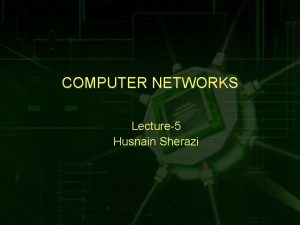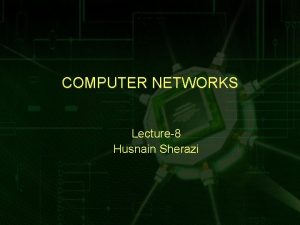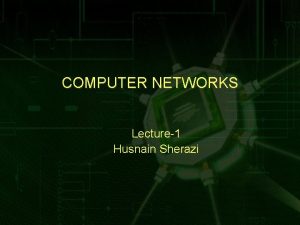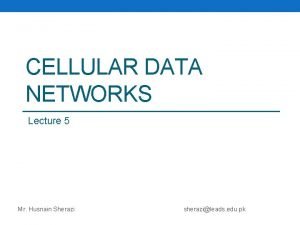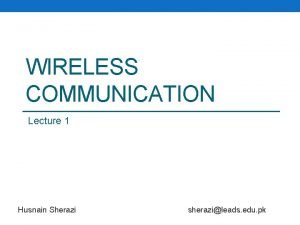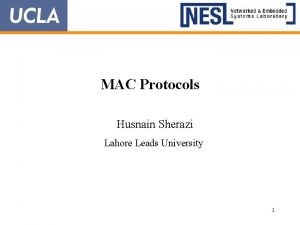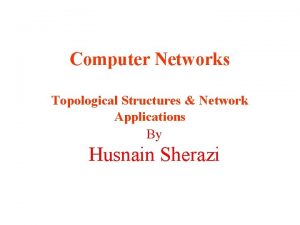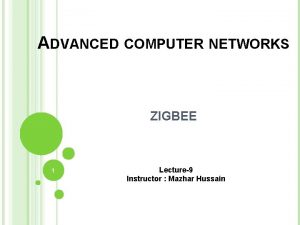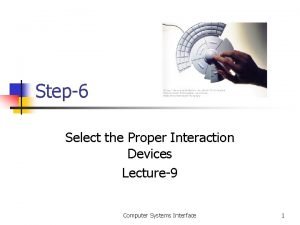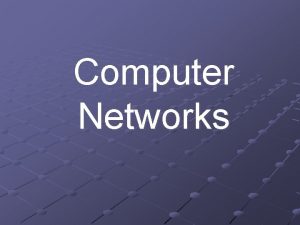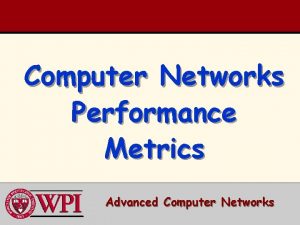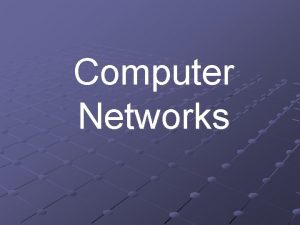COMPUTER NETWORKS Lecture9 Mr Husnain Sherazi Review Lecture


















- Slides: 18

COMPUTER NETWORKS Lecture-9 Mr. Husnain Sherazi

Review Lecture 8 w w w CSMA/CD Wireless LANs and CSMA/CA Token Ring FDDI ATM

Chapter 9 Hardware Addressing and Frame Type Identification

Introduction w Need to devise technique for delivering message through LAN medium to single, specific destination computer w w Sending computer uses a Hardware Address to identify the intended destination of a frame w w Sending computer also identifies Type of data carried in the frame

Specifying a Destination w Data sent across a shared network reaches all attached stations - for all LAN topologies w Interface hardware detects delivery of frame and extracts frame from medium w But. . . most applications want data to be delivered to One specific application on another computer - not All computers

Hardware Addressing w Most network technologies have a hardware addressing scheme that identifies stations on the network w Each station is assigned a numeric Hardware Address or Physical Address

Hardware Addressing w Sender includes hardware address in each transmitted frame w Only station identified in frame receives copy of frame w Most LAN technologies include sender's hardware address in frame, too

LAN Hardware and Packet Filtering

LAN Interface w LAN interface handles all details of frame transmission and reception w Adds hardware addresses, error detection codes, etc. to outgoing frames w w May use DMA to copy frame data directly from main memory w w Obeys access rules (e. g. , CSMA/CD) when transmitting

LAN Interface – Checks error detection codes on incoming frames – May use DMA to copy data directly into main memory – Checks destination address on incoming frames • Station's address, a copy of the frame is passed to the attached computer – Frames not addressed to the local computer are ignored and don't affect the local computer in any way

Format of Hardware Addresses w Numeric value w Size selected for specific network technology w Length is one to six bytes

Assigning Hardware Addresses w Hardware addresses must be unique on a LAN w How can those address be assigned and who is responsible for uniqueness?

Assigning Hardware Addresses Static Configurable Dynamic Hardwar e manufacturer assigns permanent physical address to each network interface. Address can be set by end user, either manually (e. g. , switches or jumpers on the inte rface ) or electronically (e. g. , through software Interfac e automatically assigns physical address each time it is powered up Manufacturer must ensure every interface has a unique address System administrators must coordinate to avoid conflict Automatic scheme must be reliable to prevent conflicts

Broadcasting

Problems with Broadcasting w For every broadcast frame on the network, each computer uses computational resources: – Places contents into memory – Interrupts the CPU – Allows system software to make a decision whether to discard or use the frame

Problems with Broadcasting – If a pair of computers, use broadcasting, instead of sending them directly, all other computers waste CPU time while discarding the frames.

Multicasting w Solution: The restricted form of broadcasting: Multicasting: – It works like broadcasting – However it does not forward frames automatically to the CPU – The interface hardware is programmed in advance to accept certain frames that have multicast address as the destination address

Summary w w w Hardware Addressing Specifying a Destination Packet Filtering Assigning Hardware Addresses Broadcasting Multicasting
 Origins of vc and datagram networks
Origins of vc and datagram networks Basestore iptv
Basestore iptv 01:640:244 lecture notes - lecture 15: plat, idah, farad
01:640:244 lecture notes - lecture 15: plat, idah, farad Computer security 161 cryptocurrency lecture
Computer security 161 cryptocurrency lecture Computer-aided drug design lecture notes
Computer-aided drug design lecture notes Architecture lecture notes
Architecture lecture notes Computer architecture lecture
Computer architecture lecture Crc in computer networks
Crc in computer networks Crc in computer networks
Crc in computer networks Traffic management in computer networks
Traffic management in computer networks Tpdu in computer networks
Tpdu in computer networks What is optimality principle in computer networks
What is optimality principle in computer networks Snmp supports which formatted protocol
Snmp supports which formatted protocol What is optimality principle in computer networks
What is optimality principle in computer networks Business application of computer network
Business application of computer network Classify computer networks based on transmission technology
Classify computer networks based on transmission technology Intro dns
Intro dns Diffserv vs intserv
Diffserv vs intserv Icmp in computer networks
Icmp in computer networks



















